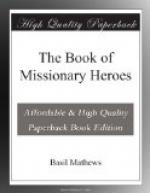So it came about that some years later in 1866, having been trained and accepted by the London Missionary Society, Chalmers, as a young man, walked across the gangway to a fine new British-built clipper ship. It had been christened John Williams after the great hero missionary[34] who gave up his life on the beach of Erromanga.
This boy, who loved the sea and breathed deep with joy in the face of adventure and peril, had set his face towards the deep, long breakers of the far-off Pacific. He was going to carry to the South Seas the story of the Hero and Saviour Whom he had learnt to love within the sound of the Atlantic breakers that dashed and fretted against the rocks of Western Scotland.
FOOTNOTES:
[Footnote 34: See Chapter VII.]
CHAPTER XIII
THE SCOUT OF PAPUA[35]
Chalmers, the Friend
(Date of Incident, about 1893)
The quick puffing of the steam launch Miro was the only sound to break the stillness of the mysterious Aivai[36] River. On the launch were three white people—two men and a woman. They were the first who had ever broken the silence of that stream.
They gazed out under the morning sun along the dead level of the Purari[37] delta, for they had left behind them the rolling breakers of the Gulf of Papua in order to explore this dark river. Away to the south rolled the blue waters between this vast island of New Guinea and Northern Australia.
They saw on either bank the wild tangle of twisted mangroves with their roots higher than a man, twined together like writhing serpents. They peered through the thick bush with its green leaves drooping down to the very water’s edge. But mostly they looked ahead over the bow of the boat along the green-brown water that lay ahead of them, dappled with sunlight under the trees. For they were facing an unknown district where savage Papuans lived—as wild as hawks. They did not know what adventure might meet them at the next bend of the river.
“Splendid! Splendid!” cried one of the white men, a bearded giant whose flashing eyes and mass of brown hair gave him the look of a lion. “We will make it the white woman’s peace. Bravo!” And he turned to Mrs. Abel, whose face lit up with pleasure at his happy excitement.
“No white man has even seen the people of Iala,"[38] said Tamate—for that was the native name given to James Chalmers, the Scottish boy who had now gone out to far-off Papua as a missionary.[39] “Iko there”—and he pointed to a stalwart Papuan who stood by the funnel—“is the only one of us who has seen them and can speak their tongue.
“It is dangerous for your wife to go among these people,” he went on, turning to Mr. Abel, “but she will help us more than anything else possibly can to make friends.” And Mr. Abel nodded, for he knew that when the Papuans mean to fight they send their women and children away; and that when they saw Mrs. Abel they would believe that the white people came as friends and not enemies.




